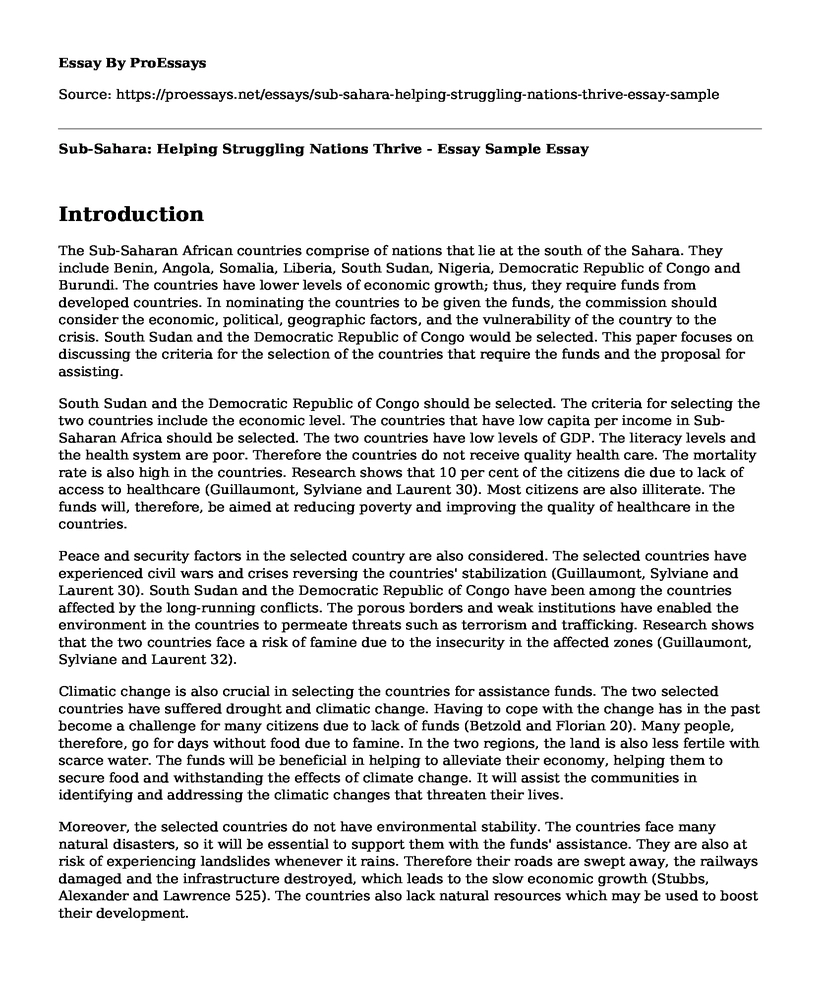Introduction
The Sub-Saharan African countries comprise of nations that lie at the south of the Sahara. They include Benin, Angola, Somalia, Liberia, South Sudan, Nigeria, Democratic Republic of Congo and Burundi. The countries have lower levels of economic growth; thus, they require funds from developed countries. In nominating the countries to be given the funds, the commission should consider the economic, political, geographic factors, and the vulnerability of the country to the crisis. South Sudan and the Democratic Republic of Congo would be selected. This paper focuses on discussing the criteria for the selection of the countries that require the funds and the proposal for assisting.
South Sudan and the Democratic Republic of Congo should be selected. The criteria for selecting the two countries include the economic level. The countries that have low capita per income in Sub-Saharan Africa should be selected. The two countries have low levels of GDP. The literacy levels and the health system are poor. Therefore the countries do not receive quality health care. The mortality rate is also high in the countries. Research shows that 10 per cent of the citizens die due to lack of access to healthcare (Guillaumont, Sylviane and Laurent 30). Most citizens are also illiterate. The funds will, therefore, be aimed at reducing poverty and improving the quality of healthcare in the countries.
Peace and security factors in the selected country are also considered. The selected countries have experienced civil wars and crises reversing the countries' stabilization (Guillaumont, Sylviane and Laurent 30). South Sudan and the Democratic Republic of Congo have been among the countries affected by the long-running conflicts. The porous borders and weak institutions have enabled the environment in the countries to permeate threats such as terrorism and trafficking. Research shows that the two countries face a risk of famine due to the insecurity in the affected zones (Guillaumont, Sylviane and Laurent 32).
Climatic change is also crucial in selecting the countries for assistance funds. The two selected countries have suffered drought and climatic change. Having to cope with the change has in the past become a challenge for many citizens due to lack of funds (Betzold and Florian 20). Many people, therefore, go for days without food due to famine. In the two regions, the land is also less fertile with scarce water. The funds will be beneficial in helping to alleviate their economy, helping them to secure food and withstanding the effects of climate change. It will assist the communities in identifying and addressing the climatic changes that threaten their lives.
Moreover, the selected countries do not have environmental stability. The countries face many natural disasters, so it will be essential to support them with the funds' assistance. They are also at risk of experiencing landslides whenever it rains. Therefore their roads are swept away, the railways damaged and the infrastructure destroyed, which leads to the slow economic growth (Stubbs, Alexander and Lawrence 525). The countries also lack natural resources which may be used to boost their development.
In assisting the two countries, the funds should be divided depending on the needs of the country. The country that experiences the most natural disaster and has the lowest GDP should be given the highest amount to help in reducing the level of poverty (Cook et al.). The one with the most inferior infrastructure should also be given higher assistance. However, the aid would be given in the form of a check to ensure the countries allocate the funds to the areas that experience crisis.
Conclusion
Conclusively, South Sudan and the Democratic Republic of Congo would be allocated the assistance funds. The two countries have a high level of illiteracy, and they have limited access to quality healthcare. The countries also face adverse climatic change with their security and peace being threatened by terrorists. They have also recently experienced famine with environmental instability which makes them the best countries for allocating the funds.
Works Cited
Betzold, Carola, and Florian Weiler. "Allocation of aid for adaptation to climate change: Do vulnerable countries receive more support?." International Environmental Agreements: Politics, Law and Economics 17.1 (2017): 17-36.
Cook, Nicolas, et al. "Sub-Saharan Africa: Key Issues, Challenges, and US Responses." Washington, DC. Congressional Research Service (2017).
Guillaumont, Patrick, Sylviane Guillaumont Jeanneney, and Laurent Wagner. "How to take into account vulnerability in aid allocation criteria and lack of human capital as well: improving the performance-based allocation." World Development 90 (2017): 27-40.
Stubbs, Thomas H., Alexander E. Kentikelenis, and Lawrence P. King. "Catalyzing aid? The IMF and donor behavior in aid allocation." World Development 78 (2016): 511-528.
Cite this page
Sub-Sahara: Helping Struggling Nations Thrive - Essay Sample. (2023, Jul 06). Retrieved from https://proessays.net/essays/sub-sahara-helping-struggling-nations-thrive-essay-sample
If you are the original author of this essay and no longer wish to have it published on the ProEssays website, please click below to request its removal:
- Analysis of the Patriot Games Book Paper Example
- Annotated Bibliography on International Migration and Economic Advancement
- Essay Example on Daryl Davis' 19-Min Speech: Understanding Racism & Why We Oppose It
- Chinese Immigrants in California: Decades of Discrimination - Essay Sample
- Essay Example on Domestic Violence: Understanding the Cause to Provide Patient-Centered Care
- Essay Sample on Discovering My Career Path: A Journey from China to Canada
- Article Review Sample on Women, Addiction & Recovery: An In-Depth Analysis







